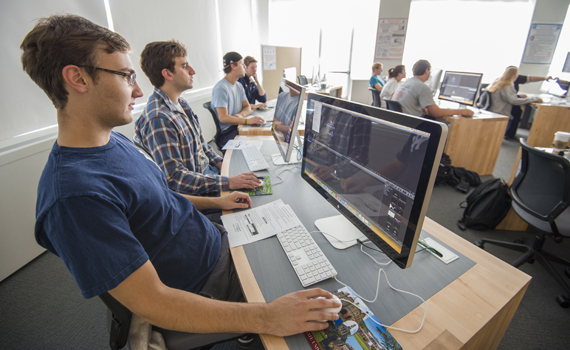
Students in Colgate’s new Anita Grover MD ’74 and Tom Hargrove, P’14 Digital Learning and Media Center.
This September, Colgate unveiled its most innovative learning-technology tool to date. The new Anita Grover MD ’74 and Tom Hargrove P’14 Digital Learning and Media Center (DLMC), named for the Colgate parents who made it possible, is now open on the fifth floor of the Case Library and Geyer Center for Information Technology. The center is already reshaping the university’s approach to 21st century higher education.
With 16 Mac workstations equipped with media editing software, it can be used as a collaborative studio, formal classroom, computer lab, showcase for student work, or meeting space. In the corner of the room, a rack with 40 terabytes of storage is connected to each of the computers via a fiber-optic network so students are able to move seamlessly between machines. The DLMC also functions as a hub for media equipment use and lending. At the front desk, students have the option to borrow Bose headphones, disk drives, voice recording systems, tripods, data projectors, portable screens, DVD players, and more.
Staffed by digital media faculty and 10 student media consultants, the facility provides maximum flexibility for undergraduates. One of the original visions for the project, put forward by managing director Ray Nardelli and University Librarian Joanne Schneider, was to “co-locate the information technologists with the research librarians so that there could be an integration of their skills when needed,” Schneider explained on the center’s opening day.
The Digital Learning and Media center, with its human and computer resources, stands as a symbol of Colgate’s investment in the future of digital learning technology, which it foresees as an integral part of higher education moving into the future. “We have a vision that the very best of a Colgate education can be transported to the 21st century and indeed enhanced, not threatened, by the new technologies. I think this is a very important moment.” President Jeffrey Herbst commented.
Students are already proving the worth of this new tool. They flow freely between the center and the library’s stacks. They collaborate while creating advertisements for their clubs and editing digital photography. Film and media studies students are analyzing short movies in the classroom, then making their own — editing footage in the lab to gain a first-hand understanding of the process behind the product.
The potential of this workspace extends outside of those involved in the direct study of film and media. It offers opportunity for students to engage in curricular explorations that go beyond text-based inquiry within any course of study. “I want my students engaging in a variety of levels,” said Marijeta Bozovic, assistant professor Russian and Eurasian studies. “I want them making subtitles for Russian films or working together to create dialogues and voiceover narration, which they can then paste over digital photo slideshows.”
The DLMC encourages faculty and students to take a new approach toward old material and to completely rediscover their field of study. “Projects like this build community and generate excitement among students,” said Bozovic. “They make language come alive, and they reinforce learning from a multitude of angles.”